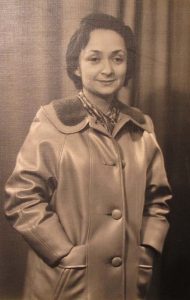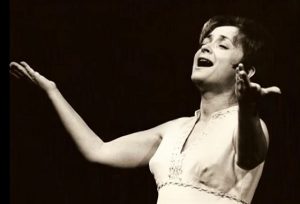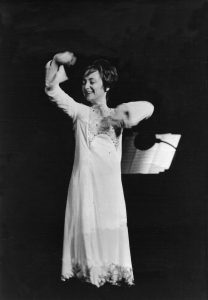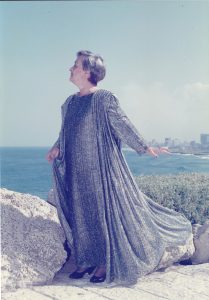Nechama Lifshitz
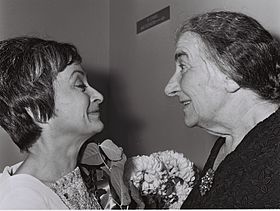 Nechama Lifshitz (Russian: Нехама Юделевна Лифшиц, Hebrew: נחמה ליפשיץ) (born 1927 in Kaunas, Lithuania, died 2017 in Tel Aviv, Israel) was a Yiddish language and later Hebrew language soprano and art song performer who came to be a key representative of Soviet Jewish culture in the 1950s and 1960s.Her seemingly innocent concerts were the heart and soul of Lipshitz’s contribution to keeping Jewish culture and identity alive in the Communist bloc.
Nechama Lifshitz (Russian: Нехама Юделевна Лифшиц, Hebrew: נחמה ליפשיץ) (born 1927 in Kaunas, Lithuania, died 2017 in Tel Aviv, Israel) was a Yiddish language and later Hebrew language soprano and art song performer who came to be a key representative of Soviet Jewish culture in the 1950s and 1960s.Her seemingly innocent concerts were the heart and soul of Lipshitz’s contribution to keeping Jewish culture and identity alive in the Communist bloc.There is no standard way of writing Lifschitz's name in the Latin alphabet, so it has been transliterated as Nehama Lifschitz, Nehamah Lipschitz, Nekhama Lifshitz, and so on, in news articles and on musical releases aimed at an English market. While she was still working in the Lithuanian SSR her name was sometimes written in its Lithuanian form Nechama Lifšicaitė, or Lifshitzaite. In YIVO transliteration from Yiddish her name would be spelled Nekhame Lifshits.
Early life
Nechama Lifshitz was born in Kaunas in 1927 before Lithuania became part of the Soviet Union. Her father, Yehuda Zvi-Hirsh Lifshitz, was a doctor, businessman and Zionist activist. Her father, who played the violin, was a musical influence on her, as well as her mother Batya who sang regularly. In her youth, she attended the Kaunas Real Hebrew Gymnasium. During the Second World War she, her parents and sister fled east to Uzbekistan ahead of the conquering German army. In 1946 she returned to Kaunas with her family. She enrolled in the Lithuanian Music Academy, where she received training to sing in the Lithuanian, Ukrainian, Uzbek, and Russian languages. At that time it was not possible to be academically trained as a Yiddish language singer except at the Yiddish State Theater in Moscow. She graduated from the Music Academy of Lithuania in 1951.
Musical career
Early in her career Lifshitz sang as a soloist in the Kaunas Opera, performing Barber of Sevilla, Rigoletto and other productions. Her first Yiddish language concert was in 1951. However, it would be several more years before she could perform more widely. During the early Khrushchev era in the Soviet Union, in the mid-1950s, some forms of Jewish cultural revival were allowed. This was mainly limited to Yiddish concerts, which helped propel singers such as Lifschitz, and others like Sidi Tal and Mikhail Epelbaum, to officially-sanctioned popularity. Other forms of expression, such as the publication of Yiddish language books, remained banned. Even with Yiddish folk music concerts, they were strictly controlled in terms of who was able to perform them, and even whether the word Yiddish could be mentioned on the poster, and so on.
In the early 1950s Lifshitz often appeared with Ino Topper, a singer who had studied with her. Around 1955 she became acquainted with Mark Braudo, a Jewish actor in Lithuania. He proposed that they start a troupe that would perform songs and scenes in Yiddish. The group was soon founded under the umbrella of the Lithuanian SSR Philharmonic. For the rest of her career in the Soviet Union she was essentially an employee of the Lithuanian Philharmonic.
However, they had little access to Yiddish music in the Lithuanian SSR, and so Lifshitz went to Moscow to meet the composers Shaul Senderei and Lev Pulver. Pulver had been director of the Moscow Yiddish State Theater for years, and gave her material by Avram Goldfaden, Sholem Aleichem and others. Senderei, on the other hand, agreed to harmonize eighteen Jewish songs for her, which would be paid for by the Lithuanian Philharmonic Society. In his memoirs, Braudo listed the repertoire in those first concerts: Pulver and Senderei's compositions, as well as the work of L. Kahan and L. Yampolsky, set to music with texts by poets Shmuel Halkin, Yosef Kotlyar, Zalman Shneur, and S. Ansky. In addition they sang songs by Mordechai Gebirtig and various Jewish folk songs. They also read poems by Shmuel Halkin and Yosef Kotlyar and Hirsch Osherovich and some short stories by Eliezer Steinberg and Sholem Aleichem.
With that material, Lifshitz gave her first Yiddish concert in Vilnius in 1956. She then made appearances in Latvia and Lithuania, in Leningrad and then in cities in Uzbekistan and Tajikistan. The following year she made more tours to Estonia, Russia, and Belorussia. It was in 1957 that the first 78 rpm recording was made of her singing.
In 1958 she won the First prize in an all-Soviet Competition for variety artists. According to Braudo, her success in that contest caught the attention of the press in Moscow, which rarely gave any coverage to Jewish artists. Thus her first concerts in Moscow were in May 1958. Many of the surviving members of the prewar Yiddish cultural world came to the concert, including Shmuel Halkin (whose poems she had performed), and the widows of Der Nister, Itzik Fefer, Perets Markish, and others. Most of the former actors of the Moscow Yiddish State Theatre attended as well. At around this time, one of the most well known Soviet Yiddish singers Mikhail Alexandrovich convinced her that she was talented enough to give solo concerts and that she did not need to travel with the Lithuanian troupe.
In 1959 the hundredth anniversary of the birth of Sholem Aleichem was celebrated in the Soviet Union with various concerts and official events. During that celebration Lifshitz gave a concert in every Soviet Republic. In Moscow she performed alongside Paul Robeson. The new material she added for the centenary concerts and a show of Sholem Aleichem "Wandering Stars" (Yiddish - Blonjedike Shtern) composed by Abraham Rubinstein, with montages by Leonid Lurie, director of the Russian Theatre in Vilnius, artist Rafael Chwoles and with music by Lev Pulver.
However, during this tour she encountered some hostility from officials, such as in Minsk, where Party Secretary for Propaganda Timofei Gorbunov forbade her concert, or in Vinnitsa, where her concert was partly censored for containing 'nationalist' materials. In Kyiv after she sang the heart-rending lullaby "Babi-Yar", by Shike Driz and Rivke Boyarsky, adjacent to the site of the Babi Yar massacre of 1941, she was not allowed to perform in the city of Kyiv anymore. Officials forced her to include more and more Russian-language material in her concerts. Nonetheless during this time she felt exhilarated by being able to perform in Yiddish for Jewish populations large or small, and that her concerts became cultural "happenings" that took on a significance beyond the performance of music.In 1959 she also performed in the Hebrew language for the first time, something which was forbidden and had barely been heard on Soviet stages since the 1920s.
In 1959 and 1960, she was permitted to perform abroad in Paris, Vienna, Brussels, and Antwerp. This tour was meant to demonstrate to the world that the Soviet Union did not discriminate against Jewish culture.In the Paris concert in March 1959, she shared the stage with Mikhail Alexandrovich. During 1960 and 1961, two LPs of her music were released by the state music label Melodiya, which would be reprinted a number of times.
In the late 1950s and early 1960s she continued to give regular concerts in the Soviet Union, although it became difficult for her to get permission to perform in cities with a large Jewish population. Even in cases where she was able to perform, she was criticized for performing "pessimistic" music about the plight of the Jews in Tsarist times and during the Second World War, and not enough about building a communist society.
As her career progressed, she added more Hebrew language materials to her concerts, and her clandestine connection with Israel increased. The amount of Hebrew content in her concerts increased in particular after 1965. She had developed a relationship with the Israeli embassy in Moscow in the late 1950s and they gave her records, scores, and books over the years. This close relationship would cause her problems with the Soviet authorities. She was asked by the KGB to avoid meeting with Israelis. In 1966 Lifshitz made her first application to emigrate to Israel, which caused her performances to be canceled by Soviet authorities for several months. However, in 1967 she was allowed to perform again, and made a number of tours in Lithuania, Siberia, and in Central Asia till 1969. At around this time she also started a written correspondence with the Israeli singer Naomi Shemer, whose family also came from Lithuania.
Emigration (Aliyah) to Israel
In March 1969 she was finally given an exit visa to emigrate to Israel. Apparently this came as a surprise to many people, and may have been a result of Leonid Brezhnev trying to interfere with the Jewish cultural revival by getting rid of some of its major figures. After a sold-out concert in April 1969 which was attended by Israeli Prime Minister Golda Meir,(who also sponsored the event) and most of her government as well as artists, writers, editors, and thousands more, she greatly reduced her performance schedule once in Israel—she later said that she "felt like a partisan when the war was over." After studying at Bar-Ilan University, in 1976 she became a librarian in the Tel Aviv municipal music library and later on the director of this library. Despite her reduced performance schedule, a number of new recordings and TV shows were made of her in the years after her arrival to Israel.
In 1978, she was awarded the Manger Prize. In 2006 she was elected chairman of the World Council for Yiddish Language and Jewish Culture. In 2004, she received the title of Honorable Citizen of the City of Tel Aviv-Yafo.
In 1997, she was invited to return to St. Petersburg to teach and perform Yiddish song at a seminar on Jewish musical culture, which gave her a connection to the younger generation of post-Perestroika Yiddish language singers in Russia. Seeing an opportunity to continue that work with a younger generation and to pass her heritage, she launched her own workshop in Israel for Yiddish vocalists which she ran almost till her death. That workshop still bears her name.
She died in Tel Aviv on 21 April 2017, shortly before her ninetieth birthday. Her personal archive of music and correspondence has been donated to the National Library of Israel.
From: Wikipedia
From the speech of Nehama Lifshitz, at a seminar in Russian dedicated to the memory of Shaul Avigor - one of the leaders of the Haganah, head of the Mossad Le'aliyah Bet, and the founder of the Liaison Bureau. The seminar was held at Ben Gurion University of the Negev, under the aegis of the Hebrew University and the Liaison Bureau, January 11, 1979, Israel.
Laugh, laough at the dreams; I, the dreamer, am speaking now... /Shaul Tchernichovsky
Dear Friends!
I come to tell you the story of my life. My personal history as I experienced it. I could say I'm just bringing you my own testimony - and of course, not as a historian. My profession is connected more to emotion than to logic.
I will begin by saying a few words about the spirit and atmosphere under whose influence my Yiddish song repertoire was created and developed - and under what circumstances it was born. It was no coincidence that after a decade on the Soviet stage I embraced my own folk and national songs. In Lithuania, where I was born and raised, Jewish culture enjoyed full autonomy. From the moment he is born, and completely unconsciously, the Jewish child breathes Yiddishkeit (Judaism). At home, in kindergarten, in youth movements, and in community life, we breathed Yiddishkeit and Jewish culture – in a way that was as simple and natural as breathing. We grew up with two mother tongues - one, Yiddish, a living language about a thousand years old - the second, Hebrew, the ancient language of our ancestors ... two languages equal in value and close to the heart ...
Abraham, Isaac, Yaakov, and Sarah; Rebecca, Rachel and Leah – these were not just historical figures to us, but were present in our lives as our true ancestors. We knew for certain where they had lived, how they had lived, and what had been the essence of their lives. Just as a living creature does not think about the way it breathes, walks, sees; how it hears, laughs and cries, likewise none of us considered the fact that our whole environment was Jewish. That's how we all were, and that's how I was. We did not research our roots as is so fashionable to do today. We were like the branches on an ancient and sturdy tree. None of us researched our roots - we just grew and aspired to grow upwards.
A people's culture is not created in one day, not in one year, and not even in a century - especially that of a people like ours, scattered all over the world and made up of different communities. The seed, hidden deep and religiously retained within each of us, is a seed that unites us all – it is unique: patriarchal heritage, the Temple and the State of Israel. A mystical fate surrounds us all. The very fact that I, Nehama, here in the heart of the Land of Israel, am forced to speak to you in a foreign language about Jewish culture to which Jews who speak all kind of languages are exposed - only emphasizes our common mystical destiny.
I was granted a charmed and magical connection with my audience. This connection grew from being part of "The Movement" (with an emphasis specifically on "The") - and I grew up together with it. As the revolutionary poet Vladimir Mayakovsky said - "The song and the verse are a bomb and a flag…" We had no intention of using weapons in our struggles against the Soviet government; but we dreamed of and needed a flag. Just like every people and nation in the Soviet Empire had a flag – we had our flag as well - the Israeli embassy building in Moscow and the blue-and-white flag hoisted above it. This had enormous significance in raising morale and spirit. We drew many spiritual powers from it, powers that filled the heart with an innate love for our country and our people - a love that forgot to fear. It is possible that this is how fighters who go into a just battle feel.
How can we bestow our young generation - who has something it can be proud of - the beauty and depth of Judaism and Jewish creativity - how to convey to them the message?
Be careful not to neglect the Levites as long as you live in your land
As to the question of "emphasis" - it is important not only "how to sing" but I would say "how and what to sing." What and how we will sing today depends on what and how and even possibly where we will sing in 20, 50 and 100 years from now.
It is necessary to find the answer, to create the atmosphere, the ground, and the way to reach the roots ... the way to breathe and grow...
Because how can you survive without air and without roots?
On Nehama Lifshitz' work (1927-2017)
taken from: Michael Lokin, Jewish Music Research Center
On Friday, April 21, 2017, Nehama Lifshitz - a heroine of Yiddish culture of the second half of the twentieth century passed away. She was a legendary singer who, to hundreds of thousands of Jews in the Soviet Union and around the world, became the symbol of Jewish revival. She was called "The Jewish Nightingale" by her admirers; she dared to sing in Yiddish a few years after the "Doctors' Trial" (January 1953) and after the obliteration of singular Yiddish literary and theatrical works.
When Nehama was in her 30's she said that she "had become a tombstone that does not exist". Tickets to her concerts all over the U.S.S.R were snatched up by thousands of fans, many of them young people who did not even know Yiddish. They filled the halls and the surrounding streets, trying to see the singer up close and maybe even touch the sleeve of her coat. A slim, short woman with a loud, clear voice, who aspired to revive - with the help of music - a culture that the totalitarian regime sought to eradicate, and succeeded in this mission: not for nothing, did Eli Wiesel, after his first visit to the Soviet Union in 1965, call her the "Queen of Soviet Jewry" .
Indeed, the main feature of her work is nobility: only the "Queen" can control both languages, Hebrew and Yiddish, even to the small gestures that make up part of the language and heritage, as well as the secrets of Western artistic poetry. She graduated from the Vilnius Academy of Music, and after appearing in leading operatic roles, Lifshitz gave up her safe operatic career "so as not to waste valuable stage time". She built a complete repertoire of Jewish songs, without having available libraries and recordings, with the help of a handful of talented friends, including composer Saul (Samoil) Sandray who only then, in the mid-1950s, returned from his long imprisonment in Siberia, Lev Polber and Lev Kogan….
The Nehama Lifshitz Yiddish Song Workshop/Article: Rosa Litai
In 1998, Nehama Lifshitz established the Yiddish Song and Poetry Workshop.
The aim of the workshop was not only to teach the students skills in performing the songs but also, and especially, to serve as a tool for passing down history and preserving the Jewish heritage and tradition baggage inherent in one-thousand years of Yiddish culture, to future generations. To ensure that all this marvelous legacy, and this immense baggage, which Hitler tried physically, and Stalin spiritually and physically, to destroy, kill and eradicate, G-d forbid, and leave no trace of it on earth, Nehama wanted to save, to preserve, and even revive it, and reintegrate it as an integral part of Israel's contemporary and renewed culture.
Nehama did not rest on her 'laurels' ... Each half year of the workshop programs, Nehama built a new program on a new theme. She was driven by a sense of the enormous responsibility resting on her shoulders to provide the most she could during her lifetime to save and delegate this rich culture to future generations, a culture that with change of language and the passing of days might be lost without us being aware...
There was yet so much work for her to do, but she was taken from us, and was prevented from continuing this great initiative, an initiative which is our duty and our mission to continue faithfully, to preserve and pass on down to future generations; thus we will fulfill the vision, dream and legacy of Nehama Lifshitz.
It can be said that the last work of Nehama Lifshitz, left us a tremendous infrastructure and tools which open a window into a wonderful Jewish-cultural world over one-thousand years old - a world that must not disappear!
Who will be able to realize Nehama's dream?
To accomplish this great task, one must first and foremost begin by organizing and cataloging all the material Nehama left in the workshops. The musical notes and the programs of all the concerts Nehama wrote and edited, during all these years, are to be found in the artistic Yiddish song workshop named after Nechama Lifshitz. We would like to ask the person who has been helping her with dedication throughout the years, Ms. Regina Dricker, who currently serves as workshop director, to undertake as another and separate project (for a fee) the cataloging and scanning of the musical notes and programs, to enable these materials to be used as study and enrichment materials, according to the unique method of the late Nechama Lifshitz, and which I ask to be officially named: "The Nechama Lifshitz, Yiddish Song Study Program Method."
In addition, I have many other materials left by Nehama, which must also be added and integrated into a complete archive of Yiddish songs, and other areas with which Nehama Lifshitz, was involved.

